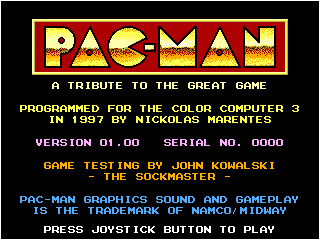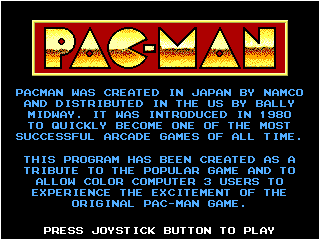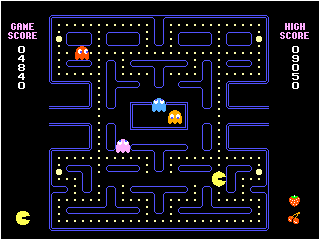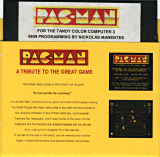 After leaving the Tandy Color Computer
scene in 1992, I spent most of my computer time playing with Commodore
Amigas. I had an Amiga 1000 and then moved on to an Amiga 1200. I liked the
Amigas, great hardware and an efficient, reliable and responsive OS but I
never programmed anything for it. When Commodore folded and the resurrection
of the Amiga by another company was looking more like a myth, I jumped onto
the PC bandwagon with a Celeron 300 Mhz system. I hated Windows! It was the
complete opposite of what the Amiga OS was except that it had a huge software
base and was supported by so many companies with their products. It was clear
that this was the future of home computing (over 90% market share!). After leaving the Tandy Color Computer
scene in 1992, I spent most of my computer time playing with Commodore
Amigas. I had an Amiga 1000 and then moved on to an Amiga 1200. I liked the
Amigas, great hardware and an efficient, reliable and responsive OS but I
never programmed anything for it. When Commodore folded and the resurrection
of the Amiga by another company was looking more like a myth, I jumped onto
the PC bandwagon with a Celeron 300 Mhz system. I hated Windows! It was the
complete opposite of what the Amiga OS was except that it had a huge software
base and was supported by so many companies with their products. It was clear
that this was the future of home computing (over 90% market share!).
What was also clear to me was that the days of creating commercial software
as a one man show operating from a bedroom were over. It was hard to make
a dent in this market unless you joined up with a software company. I had
also fallen far behind with current popular programming languages like "C"
and was unfamiliar with game programming on the PC. Yep! I was an old dog
that couldn't learn any new tricks!
So, I did what all "old dogs" do and that is search around for other "old
dogs" to talk about the "good-old-days" and I found it in the form of the
CoCo newsgroup on the internet.
I was surprised to see that there was still some life in the Color Computer.
I discovered new programs that other Color Computer enthusiasts had written
during my years of absence. I made some good friends like Jim Davis who at
the time was running a disk based magazine called "CoCo Friends Disk Magazine"
(CFDM). John Kowalski who in my opinion is the greatest Color Computer 3
"hacker" (The old definition, not the new 'bastardized' version!) who has
managed to make the machine do things that it wasn't suppose to do. Steve
Bjork, the most famous of Color Computer game programmers. And many others
whom if I am to name would fill the rest of this page and constituted most
of the Color Computer community at the time.
I was starting to get the bug again and I decided to create just one more
game.
Original Story Pretext
"You are PAC-MAN, a friendly-looking yellow circle with a little wedge
missing. You travel through the maze, eating dots in your path and are pursued
by four ravenous monsters. If any of them catch you, you're a goner.
There are four 'energizers', one in each corner of the maze. Hit the
energizers and the monsters are rendered helpless and you can eat them, making
them disappear for a few seconds.
If you eat all the dots on the board, you are rewarded with another board,
in which the monsters have become smarter and stronger."
I think everyone knows this story and for those who don't.... you missed
a great era in the history of video games! :)
Game Development
I set myself an important design goal for this project. It had to look, sound
and play as close to the original Namco classic as possible. I didn't want
to do Namco the injustice of another poor clone and I wanted to do the Color
Computer 3 justice by showing what could be achieved. The game had to run
at 30 frames per second, the maximum frame rate of a standard TV or CM-8
RGB monitor (the monitor sold by Tandy specifically for that computer).
I should point out that at the time, I didn't have the MAME arcade emulator
for PC/MAC. Instead, I re-created all the game graphics by redrawing them
on my Amiga based on observing a real Pac-man machine and what I could find
in magazines. The sounds were sampled on the Color Computer off tape recordings
made from a real Pac-man machine.
I improved on my 2 channel sound routines from Cosmic Ambush to the point
where sound generation took up minimal CPU time. I improved on my sprite
graphics routines to achieve more speed. I used the tallest vertical resolution
I could muster on the Color Computer 3 of 320 x 225 pixels. I allowed the
maze to take up this full height by moving the score displays to the left
and right sides of the maze. This allowed me to create a screen aspect ratio
that wasn't too far off from the original. I included all the animated interludes
between mazes just as the original and also added the feature from the original
where the Pac-man moves slightly slower than the ghosts when eating dots
but gains a slight distance when it is taking corners. This is an important
characteristic used by expert players of the original.

Information Page |

Game Screen |
One area I could not work out from the original was the ghost character's
intelligence algorithm so I had to develop my own. I spent some time trying
to think up of an algorithm that would give similar results to the original
and this is what I came up with...
I created 4 "target" points on the screen positioned in the 4 corner areas
of the maze. Each of the 4 ghosts is given one of these targets points and
they work their way to each of these points. I set a timer on these target
points and when the timer count reached zero, they would roll their positions
into the next target point in the list. So, a target point pointing in the
top left corner of the maze would shift to the bottom right after a time,
then to the top right, then bottom left before finally returning to the top
left. This kept each of the ghosts "patrolling" the maze without them bunching
together for too long.
As each ghosts navigated the maze to reach its target point, it would check
to see if the Pac-man was on the same row or column position on the screen.
If it was, the target point is altered instantly to point to the position
of the Pac-man. The ghost would then begin to close in on this point until
the timer timeout reset the target point back to its normal cycle.
With this algorithm, the ghost movement is very similar to the original when
viewed at a glance. I was happy with the results of the gameplay and that
is how it stayed.
Marketing and Sales
 I kept my expectations low for sales
of this game. There was no Tandy to sell through, no local clubs, no printed
magazines (except CFDM the disk magazine) and not a large user base. I had
set a top end projection of 20 copies. I sold 60 which is pretty good considering
the conditions. I kept my expectations low for sales
of this game. There was no Tandy to sell through, no local clubs, no printed
magazines (except CFDM the disk magazine) and not a large user base. I had
set a top end projection of 20 copies. I sold 60 which is pretty good considering
the conditions.
I sold almost all my copies to US customers. The local Australian Color Computer
scene seemed non-existent. Thanks to my good friend Jim Davis who acted as
my US distributor and who also helped me to attend 2 Color Computer fests
in the US - more in later pages. It gave me the confidence to continue with
more Color Computer product development.
|